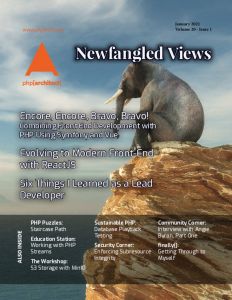PHP has been a leading language for web development for over twenty-five years, coexisting with HTML, CSS, and JavaScript to create a full front and back end application. JavaScript frameworks have skyrocketed in popularity, but it can often be challenging to see how to integrate these frameworks with your PHP web application. Symfony Encore gives us a great way to incorporate any front-end framework with PHP. Let’s take a look at how this works using Vue JS and Symfony.
Using PHP templates to render all the HTML that makes a web application sometimes has drawbacks. Good client-side libraries in JavaScript exit to help build highly dynamic, reusable Web fragments and achieve optimal user interaction. This article introduces the ReactJS approach and a few hints for gently migrating some of the PHP-generated HTML code back to its natural habitat in the client tier.
Being a Lead Developer is a fun, engaging, and responsible adventure. Becoming one is not something that happens from one day to the next. It is something you grow into by raising your voice, taking action, and responsibility. I’ve learned many things working as a Lead Developer. Still, I’d like to share six lessons, which were the most important or sometimes the hardest for me.
Welcome to a new year! In our last puzzle, we started building a collection of related functions to output and navigate through a grid, starting with printing our grid to a command-line using dark and light shade characters to indicate wall or open path, respectively. In this article, we look at plotting a route from the entrance (top-left) to the exit (bottom-right) of our grid.
Even with today’s larger servers and more abundant resources, web applications still need to be mindful of what resources they are using. While the days of worrying about every bit of memory have gone, many applications still work with data sets in the tens or hundreds of megabytes in size. We may not think about it, but consider the size of some of the databases we work with. Now imagine that you are working with all that data directly instead of through the database. How do we work with all of that?
This month, we’re diving into running our own S3 compatible open-source server via the open-source project MinIO. We’ll configure MinIO alongside our local development environment to quickly replicate our application’s integration with S3 object storage without operating on “production” storage buckets or having to set up “dev” buckets.
While completing the Deep Analysis we discussed last month, I was faced with the inability to test. That’s because—I discovered–accounting data cannot be erased—even in the sandbox. There’s no way to begin each test with a clean test environment. This month we walk through a relatively convoluted solution. We’ll capture the accounting data as we send it through the API, along with capturing data at various points along the way.
Any scripts or styles you include into your web application are called “subresources.” As these files can impact your application’s overall operation, it is critical for writing secure software that you ensure the integrity of any subresource loaded into the page. Otherwise, an untrusted party might inject malware, cryptocurrency miners, or another malicious payload into user users’ browsers.
Now on Drupal 9, the community isn’t slowing down. This month, we sit down and talk with Angie Byron, a.k.a Webchick, a Drupal Core committer and product manager, Drupal Association Board Member, author, speaker, mentor, and Mom, and so much more. Currently, she works at Aquia for the Drupal acceleration team, where her primary role is to “Make Drupal awesome.” We talk about Drupal, coding, family, and her journey throughout the years.
The more some things change, the more some things stay the same—especially when you are a PHP developer. Being a developer is an exciting, stressful, exhausting, invigorating thing. With technologies constantly evolving, our job is as much about learning as it is about building and fixing.




Leave a comment
Use the form below to leave a comment: